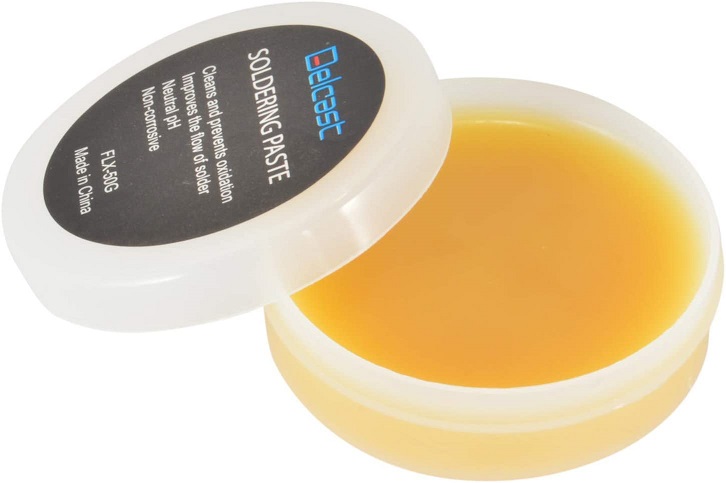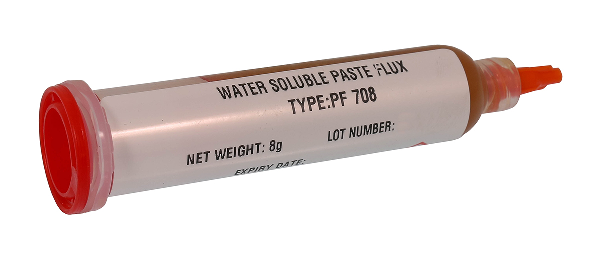Do you know what a soldering flux is? Well, if you don’t, you can find that below. In this article, you will find out what a soldering flux is and what are its common types. So, let’s roll in.
What is Soldering Flux?
You can think of soldering flux as a chemical substance used in hand soldering or in PCB assembly. It’s more of a cleaning agent that helps in removing oxides and impurities from the surfaces. All in all, it helps in effectively soldering the joints by cleaning the surface. One of the key points behind a solid solder joint is a clean metal surface free from oxides, grime, and dust. And this is what the soldering flux is used for.
Types of Solder Flux
Here are some common types of soldering flux you will find: –
Types of soldering Types of solders How to use soldering iron? How to use solder flux? How to clean soldering iron?
Rosin Flux
This flux type is usually made from extracts of oleoresin pine trees. There are 3 different categories:
Rosin Activated or RA Flux: It’s the most active type of rosin flux that leaves the most residue after the process of soldering. Rosin Mildly Activated: You can use this flux to clean plated lands or solder coated leads. Rosin Flux: This type of rosin flux is not active at all; it Is used for the surfaces, which are already clean and leaves nothing after soldering.
Pros
The full rosin flux can deliver excellent soldering. It can clean the metals you want to solder and can stay there until the process is over. Rosin flux is as useful as the water-soluble flux but comes without its downsides. It means the rosin flux won’t damage or corrode the surface. The Rosin flux can act as a barrier once the soldering process is done. It traps the ionic resides, preventing them from moving all over and reacting.
Cons
The downside of rosin flux is that it leaves a residue in the PCB board. The rosin flux can also contaminate the manufacturing equipment. Also, in harsh conditions, rosin flux seems to work inefficiently. Cleaning the rosin flux can be quite expensive too. However, if you use a solvent, you can forget about its downside. All in all, rosin is an excellent and reusable flux type.
Water Soluble Flux
This is also known as organic acid flux. It is made from organic substances other than rosin. This type of flux is excellent as it comes with an excellent flux activity. Also, such fluxes have an excellent ability to clean or remove the oxides for soldering purposes. However, you need to be quite careful while cleaning PCB assemblies with this flux. It can sometimes cause flux contamination.
Pros
When it comes to soldering, water-soluble flux is the best option. This type of flux comes with a lot of activity, which cleans the metal effectively before soldering. Also, this flux type never burns during the process of soldering.
Cons
But the downside of this flux type is the aggressive nature. Such flux types can be corrosive and can react with the metal even after soldering. It’s the reason why it’s recommended to clean this off the surface after the soldering process. Once the soldering is done, the surface should be monitored to notice signs of ionic contamination. And this is quite a hassle. Water-soluble flux can also cause dendritic growth. It’s a hair-like structure that can appear between the conductor paths. All in all, water-soluble fluxes bring along aggressive chemistry, which can cost you quite a few bucks to use. This flux type has been used in the past, but now, you should avoid it if possible.
Low-Solids/No-Clean Flux
Unlike other flux types on it, this flux doesn’t require any cleaning once you’re done soldering.
Pros
This flux type comes with the least activity and chemistry. It was developed to eradicate the need to clean the residue. And it does that precisely because of the low activity. It never reacts once the soldering process is done. Also, you don’t have to clean as there’s no residue left behind. However, there are different types of no-clean fluxes with different compositions. And its composition can determine how well it will perform.
Cons
Now, for good soldering, the flux needs to be quite active. And this is what lacks in this type of flux. The no-residue flux comes with low chemistry and activity, which makes it less effective for soldering.
Choosing the Best Flux for Soldering
When it comes to finding the best flux for soldering, it pours down to the purpose you need it for. Also, there are certain factors you can consider before making the decision. Here are the factors you can consider: –
Type of PCB you’re working with. There are three types: – Multi-Layer Double-Sided Single-Sided Type and density of the electronic components you want to solder The soldering process you want to use. There are three standard processes: – Wave Soldering Had Soldering & SMT The solder ability of the metals you need to join
Conclusion
Water-soluble flux can be aggressive or over reactive in nature, and no reside flux can be inactive. So, when you’re looking for the right kind of soldering flux for electrical purposes, you can prefer the rosin flux. It may sometimes leave a residue behind, but it is highly effective. However, if you’re dealing with plumbing work, you can go for the acidic or water-soluble flux. So, make sure to determine the purpose of the soldering before choosing the flux type. This way, you’ll undoubtedly find the right kind of flux without any complications. Comment * Name * Email * Website
Δ








![]()